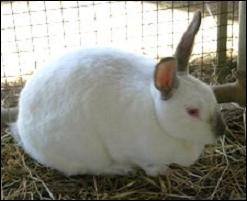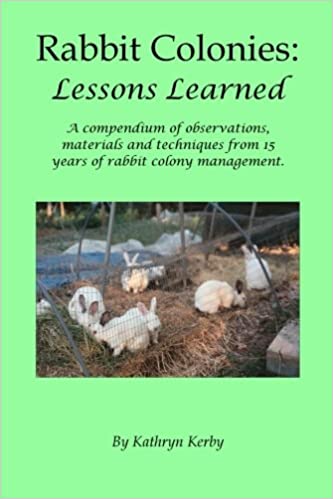|
Search this site for keywords or topics..... | ||

Custom Search
| ||
Rabbits

Rabbits are extraordinary creatures. Small, quiet, easy to work with, productive, multi-purpose, relatively easy to feed, and suitable for a wide range of urban, suburban or rural environments. For folks who are trying to improve their food security or self reliance, rabbits are very good candidates for meat and/or fiber production. They also make nice pets. Yet there is a learning curve involved, regardless of an owner's goals for their pet or herd. We have compiled information in the following categories to help folks get started and succeed with rabbits. If you're looking for specific information and can't find it here, Contact Us and we'll add it to the set of pages listed below.
Nutrition and Feeding
Many, many folks buy pelleted feed from the feed store, 25lbs or 50lbs at a time, and that works just fine for them. Other folks very much want to provide a more natural and/or varied diet, perhaps grown at home. And most folks would like to trim the cost of feed if possible and practical. Feeding either commercial rabbit herds or pet bunnies is not complicated. Yet pet owners and herd managers should review the guidelines and be familiar with currently recommended options. On our Feeding Rabbits page, we'll look at what rabbits eat, how best to provide a balanced rabbit ration, and ways to save money in the process.
Rabbits On Pasture
Many folks get frustrated with the sterile cages used in standard rabbit housing,and/or would like to house their animals as naturally as possible. Many folks also want to harvest all that wonderful manure without back-breaking labor. What better way to accomplish both goals, than to keep rabbits on pasture? We have been experimenting with this approach for several years, and there are some wonderful advantages but a few drawbacks as well. Click here to learn more about what we've done and what we've learned.
Hutch Plans
Rabbit housing has come a long way from the traditional raised wooden hutch with chicken wire. Now owners can choose from a wide variety of housing options including stacked cages for space efficiency, mobile pens which allow grazing, raised or suspended cages to capture and use rabbit manure, and indoor cages which give pet bunnies a protected place to eat and sleep. Our page on rabbit hutch plans provides a variety of rabbit housing design criteria and a number of downloadable hutch plans suitable for a wide range of hobby or small scale purposes.
Breeds
Rabbits come in a dizzying array of breeds, colors, sizes and purposes. We'll take a stroll through the more common varieties and provide resources on where to learn more about each. We'll also take a look at some rare breeds and what's being done to protect that genetic diversity.
Colony Housing
Rabbits are social creatures, and conventional housing typically calls for one rabbit per cage. While this is easier to manage, it is very hard on these creatures who love to sleep together, groom together and otherwise spend time with other rabbits. Colony housing, on the other hand, is a management style which preserves much of the natural rabbit social order, while still allowing for efficient and hygenic management.
Pet Bunnies
Rabbits make wonderful pets, either indoor or outdoor. They have some of the same advantages as dogs or cats, along with a few of their own qualities. Yet they also pose some challenges for potential owners. We'll take a look at how rabbits can become treasured members of the family, and how to keep everyone happy in the process.
Fiber Production
Many folks know that sheep and llamas provide wool and fiber for spinning, but so do some rabbit breeds. Angora rabbits are a very practical, and potentially lucrative way to produce wonderful natural fiber for a variety of spinning and craft purposes. Yet these rabbit breeds require additional care, proper housing and good nutrition so that they can stay healthy and live a good life while providing all that glorious fiber. We'll be writing up some pages on this topic too. Check back here for progress on that topic.
Meat Production
Few domestic animals can beat the rabbit for providing affordable, high quality meat. They are a perfect choice for folks who want to control their own meat supply, and they can be a profitable option for farms which want to sell meat either for human consumption or as pet food. Yet it's not easy money, and mistakes can be costly. We'll take a look at what it takes to raise meat rabbits for the table, or for sale.
Books
There are a few very good books on the market for standardized rabbit management, and we recommend that beginning rabbit owners look through them for all the experience and wisdom they contain. But there are also some very good books which are not so common which we also recommend, because they offer related information which rabbit owners, new and experienced, may benefit from. We offer a collection of these books on our Rabbit Books page.
Rabbit Biology and Behavior
Ever wondered how fast a rabbit's heart will beat while at rest? Or what a bunny's normal body temperature is? Do they like the rain? Do they like to dig? Do they really dig holes and eat carrots and thump loudly like Bugs Bunny? We'll take a look at some interesting rabbit trivia, while also providing important information for rabbit owners.
Coloring Pages
Are you looking for some fun crafts projects for your kids? We've put together a collection of free rabbit images which are suitable for printing out and coloring in with whatever rainbow of colors seems best.
Rabbits at Frog Chorus Farm
We have raised rabbits for meat, purebred breeding stock and pets since 2000. We have worked with a variety of breeds, including the following:
New Zealand (white, red and black)
Californian
Silver Fox
Sable
Flemish Giant
Most of our 2014 production is already spoken for. We do have a limited supply of non-reserved rabbits for the 2014 season. If you are interested in purchasing breeding stock, please Contact Us for more information.
Our Successful Farming and Ranching Books

We released our very first self-published book. The Chicken Coop Manual in 2014. It is a full color guide to conventional and alternative poultry housing options, including 8 conventional stud construction plans, 12 alternative housing methods, and almost 20 different design features. This book is available on Amazon.com and as a PDF download. Please visit The Chicken Coop Manual page for more information.

Rabbit Colonies: Lessons Learned
We started with rabbits in 2002, and we've been experimenting with colony management ever since. Fast forward to 2017, when I decided to write another book, this time about colony management. The book is chock-full of practical information, and is available from both Amazon and as a PDF download. Please visit the Rabbit Colonies page for more information.
The Pastured Pig Handbook
We are currently working on our next self-published book: The Pastured Pig Handbook. This particular book addresses a profitable, popular and successful hog management approach which sadly is not yet well documented. Our handbook, will cover all the various issues involved with pastured hog management, including case studies of numerous current pastured pig operations. If you have any questions about this book, please Contact Us.